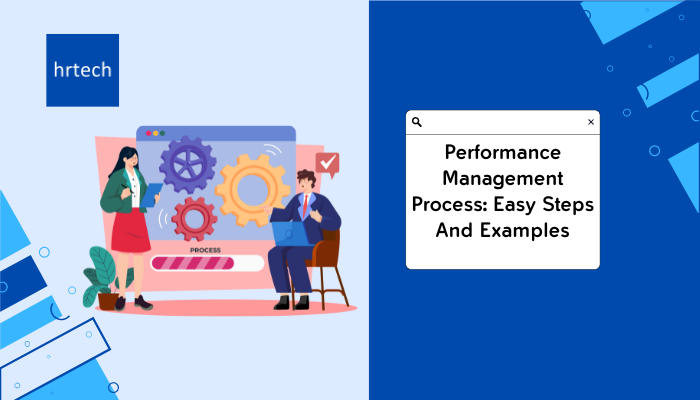Introduction
Performance management is no longer just a once-a-year HR activity. It has evolved into a continuous, dynamic process that directly shapes business outcomes, employee engagement, and company culture.
In this complete guide, we’ll take you through everything you need to know about the performance management process—from its critical stages and step-by-step execution to how big companies like Google and Deloitte are doing it differently. Plus, we’ll talk about common mistakes, compliance tips, and how performance management varies across roles.
Let’s jump in.
What Is Performance Management?
At its core, performance management is a structured approach to aligning employee goals with organizational objectives through continuous feedback, coaching, and development.
Rather than just ticking boxes during an annual review, effective performance management is about:
- Setting clear goals
- Tracking progress consistently
- Providing real-time feedback
- Offering coaching and support
- Evaluating performance fairly
- Recognizing contributions
- Driving personal and professional growth
Why Traditional Performance Management Systems Are Failing?
Let’s address the elephant in the room—why are companies moving away from traditional annual reviews? Here are some plausible reasons:
1. Lack of Timeliness
Annual reviews often come too late. By the time feedback is shared, the opportunity to act on it has passed.
2. One-Size-Fits-All Approach
Traditional systems don’t take into account the nuances of different roles, departments, or working styles (e.g., remote vs. in-office).
3. Low Employee Engagement
Employees feel evaluated rather than empowered. This contributes to disengagement, especially among Millennials and Gen Z workers who prefer ongoing dialogue and development.
4. Failure to Track Real-Time Performance
Without regular check-ins, organizations miss out on capturing real-time progress, issues, or achievements.
That’s why companies like Accenture and Deloitte have ditched the annual review model in favor of agile, continuous performance management systems focused on growth, feedback, and alignment.
Key Stages of the Performance Management Process
To understand the full scope, here’s a breakdown of the four primary stages of any performance management framework:
1. Planning
- Define SMART goals (Specific, Measurable, Achievable, Relevant, Time-bound).
- Align individual goals with team and organizational objectives.
- Collaborate with employees for stronger commitment.
2. Monitoring
- Use real-time tools and KPIs to track ongoing performance.
- Conduct regular check-ins to review progress and offer feedback.
- Address performance gaps before they escalate.
3. Reviewing
- Conduct formal appraisals to evaluate performance.
- Gather feedback from multiple sources (e.g., 360-degree feedback).
- Use data to guide growth discussions, not just evaluate.
4. Rewarding
- Recognize accomplishments through bonuses, promotions, or meaningful praise.
- Create a culture that values both effort and outcomes.
- Ensure fairness and transparency in rewards.
7 Essential Steps in the Performance Management Process
To make performance management truly effective, it needs to follow a clear and structured path. These seven key steps will help ensure everyone stays aligned, motivated, and on track to meet both individual and company-wide goals. Let’s break down each step and see how you can apply them in your organization.
Step 1: Setting Clear Goals
Clear goal-setting is the foundation of performance success. Here’s how to do it right:
- Use SMART goals to remove ambiguity.
- Encourage employees to participate in goal-setting to improve ownership.
- Align goals with larger company OKRs (Objectives and Key Results).
Example: Instead of “Improve team communication,” try “Hold weekly stand-up meetings with 100% team participation for Q3.”
Step 2: Establishing Performance Standards
Once goals are in place, define how success will be measured:
- Identify KPIs for each role. For a sales rep, it might be monthly revenue. For a designer, it could be campaign turnaround time and quality.
- Tailor standards to specific roles and seniority levels.
- Make sure every employee understands how their performance is tracked.
Tip: Keep standards visible through performance dashboards or shared trackers.
Step 3: Monitoring and Measuring Performance
This step involves consistent tracking, not micromanagement.
- Set monthly or bi-weekly check-ins.
- Use software like Lattice, 15Five, or BambooHR for seamless progress tracking.
- Encourage self-assessments and peer feedback.
Remote teams especially benefit from clear performance metrics and digital tracking tools to stay aligned.
Step 4: Providing Feedback and Coaching
Feedback isn’t just correction—it’s a development tool.
- Give real-time, actionable, and behavior-based feedback.
- Focus on improvement, not criticism.
- Build a culture where feedback is two-way and welcomed.
Example: “Your insights during the team meeting really helped clarify our campaign strategy. Let’s build on that by having you lead next week’s creative discussion.”
Step 5: Conducting Performance Appraisals
While continuous feedback is key, structured appraisals still have a place.
- Use 360-degree feedback to ensure holistic input.
- Focus on growth, not just grading performance.
- Create an actionable development plan for the next cycle.
Pro Tip: Prepare documentation in advance—no one likes a vague or rushed review.
Step 6: Recognizing and Rewarding Performance
Recognition can be a game-changer for motivation.
- Offer both monetary (bonuses, raises) and non-monetary rewards (extra time off, public shout-outs).
- Tie rewards to outcomes and effort.
- Make sure rewards are inclusive, consistent, and transparent.
Fun Idea: Create a peer-nominated reward system to foster team appreciation.
Step 7: Continuous Improvement and Development
This is where true high-performance cultures are built.
- Help employees identify skill gaps and create a Personal Development Plan (PDP).
- Offer resources like courses, mentorships, or job rotation programs.
- Encourage growth mindsets across all departments.
Remember: Development shouldn’t only be for underperformers—top talent needs growth too.
Common Mistakes to Avoid in Performance Management
Even with the best intentions, performance management can fall flat if certain pitfalls aren’t avoided. From setting vague goals to neglecting regular feedback, small missteps can lead to disengaged employees and missed objectives. In this section, we’ll highlight some of the most common mistakes managers make—and how you can steer clear of them to build a stronger, more effective process.
Here are some major pitfalls organizations often fall into:
- Unclear goals – Vague or shifting goals confuse employees and lead to poor focus.
- Infrequent feedback – Waiting for quarterly reviews leads to missed improvement opportunities.
- Lack of follow-through – Failing to revisit goals and feedback undermines the process.
- Bias in reviews – Favoritism or lack of objectivity leads to unfair evaluations and morale issues.
- Ignoring role-specific needs – What works for one department may not work for another. Customize approaches.
Solution: Use structured frameworks, review templates, and feedback training to improve consistency and fairness.
Legal and HR Compliance in Performance Management
Performance management isn’t just about motivation—it plays a critical role in HR compliance and legal protection.
Here’s what every business should keep in mind:
1. Document Everything
- Keep a trail of all feedback, appraisals, and performance issues.
- Use digital tools to store review records securely.
2. Avoid Discriminatory Practices
- Reviews must be objective and based on performance—not personal traits.
- Train managers on unconscious bias and equal opportunity laws.
3. Create Clear Policies
- Define performance expectations and consequences for underperformance.
- Outline escalation processes and appeal rights.
Having documented, compliant processes helps avoid wrongful termination claims and supports fair workplace practices.
How Performance Management Differs Across Roles
Not every role in a company can be managed the same way—and performance management should reflect that. What works for a front-line employee may not be effective for a senior executive or team leader. This section takes a closer look at how performance management shifts depending on the role, helping you fine-tune your approach for better results at every level.
Individual Contributors
- Focus on skill development and task ownership.
- Use detailed KPIs tailored to their specific output.
Team Leaders
- Evaluate leadership qualities, delegation, and team outcomes.
- Emphasize communication, mentorship, and project delivery.
Executives
- Tie performance to business metrics, innovation, and strategic initiatives.
- Include board-level feedback and organizational impact.
Remote Employees
- Use tools for visibility: Slack updates, Zoom check-ins, performance dashboards.
- Focus on outcomes, not hours worked.
One-size-fits-all doesn’t work—tailor your approach based on role, responsibility, and working style.
Performance Management Process Examples From Leading Companies
1. Accenture
Accenture, a global professional services company, has moved away from annual performance reviews. Instead, they’ve adopted a more continuous approach called “Performance Achievement”. This process includes:
- Setting priorities and expectations at the beginning of the year
- Having regular check-ins between managers and employees
- Providing real-time feedback and coaching
- Conducting future-focused conversations about growth and development
Accenture has found that this approach leads to higher employee engagement and better business results.
2. Deloitte
Deloitte, another professional services firm, has also transformed its performance management process. They’ve replaced annual reviews with a system called “Performance Snapshot”. This process involves:
Setting short-term goals and expectations
- Providing regular feedback and recognition
- Conducting quarterly check-ins to discuss progress and make adjustments
- Focusing on employee development and growth
Deloitte has seen significant improvements in employee satisfaction and retention since implementing this new approach.
3. Google
Google is known for its data-driven approach to management. Their performance management process, called OKRs (Objectives and Key Results), involves:
- Setting ambitious, measurable goals at the company, team, and individual levels
- Regularly tracking progress and providing feedback
- Conducting quarterly performance reviews to assess performance and set new goals
- Providing opportunities for learning and development
Google’s OKR system has been adopted by many other companies and is credited with driving their incredible growth and success.
4. Kelly Services
Kelly Services, a staffing and recruitment company, has implemented a performance management process that includes:
- Setting clear expectations and goals
- Providing regular feedback and coaching
- Conducting quarterly performance discussions
- Focusing on employee development and career growth
Kelly Services has found that this approach leads to higher employee satisfaction and better business results.
Final Thoughts
Performance management is an important process for any organization looking to achieve its goals and create a high-performance culture.
Once you set clear expectations, and start monitoring progress, providing feedback and support, and recognizing good work, you can help every employee reach their full potential.
Want to enhance your HR skills? Check out industry-leading training courses and certification programs at hrtech. Learn more now!




